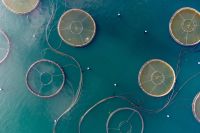The International Max Planck Research School for Molecular Life Sciences (IMPRS-LS) is a PhD program that brings together two renowned Munich-based Max Planck Institutes as well as two leading German universities, the LMU and TUM, to deliver first-class doctoral training to some of the world‘s most promising young scientists.
Applications are now open for fully funded PhD programmes with IMPRS-LS. The closing date is 15 November 2022, with accepted candidates commencing research project between March and October 2023.
For more information please download the attached announcement, or refer to IMPRS-LS website for eligibility criteria and online applications.
Brackish waters offer good prospects for future aquaculture development, as there are fewer competing uses for these resources. Kilarkollai Village (Tamil Nadu, India) has brackish waters on the village periphery, which are under utilised. The majority of the population are landless poor, economically and socially marginalised, and live below the poverty line. A team from the ICAR-Central Institute of Brackishwater Aquaculture demonstrated nursery rearing technologies in partnership with four Scheduled Caste families from the village, with a view to providing supplementary livelihoods and income. The team provided training, initial inputs and technical support.
Ocean University of China and partners will convene the forum from 20 to 22 November 2022. The forum will cover the following: Topic 1: International talent cultivation and training;Topic 2: Science and technology innovation; Topic 3: Industrial synergy. The forum will host discussions about the implementation of the “Blue Transformation” strategy, further expansion of the space for fisheries and aquaculture, and ways of improving the production capacity of aquatic products, with the purpose of facilitating the achievement of the UN Sustainable Development Goals. Participation is free but registration is required. Registration closes on 22 October.
In this issue:
Training Course on Mariculture Technologies in Asia-Pacific; FAO/NACA Virtual Workshop on Aquaculture Transformation in Asia and the Pacific Region; Belt & Road Forum for International Freshwater Fishery Industry Innovation; 8th Global Conference on Gender in Aquaculture and Fisheries, 21-23 November; Reported Aquatic Animal Diseases in the Asia-Pacific Region during the First Quarter of 2022; International Training Course on Biology and Pathology of the Penaeid Shrimp 2022; Angkasa Putra inaugurated as first President of the South-East Asian Fisheries and Aquaculture Student Association; Artemia webinars: Video recordings of technical presentations available.
GAF-8, the 8th Global Symposium on Gender in Aquaculture and Fisheries – will be held from 21-23 November, 2022, hosted by the Society of Fisheries Technologists (India) (SOFTI), Kochi and the ICAR-Central Institute of Fisheries Technology, Kochi. GAF-8 is a stand-alone event, that will be packed with a variety of different activities and sessions covering all aspects. The GAF8 session and event themes, call for abstracts and other information will be available shortly. Please see the GAF website for registration and other details.



